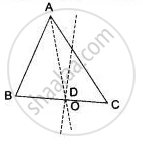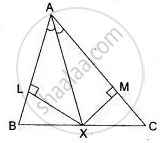Advertisements
Advertisements
Question
Given a Δ ABC with unequal sides. Find a point which is equidistant from B and C as well as from AB and AC.
Solution
Draw the angular bisector of ∠A and perpendicular bisector od side BC of Δ ABC.
Let these two bisectors meet at point O. Hence'O' is our required point.
Proof: Since, O lies on the right bisector of BC.
∴ O is equidistant from B and C.
Again, since O lies on the bisector of ∠A, formed by AB and AC.
So O is equidistant from AB and AC.
APPEARS IN
RELATED QUESTIONS
Use ruler and compasses only for the following questions. All constructions lines and arcs must be clearly shown.
Construct the locus of points at a distance of 3.5 cm from A.
Use ruler and compasses only for the following questions. All constructions lines and arcs must be clearly shown
Construct the locus of points equidistant from AC and BC.
Use ruler and compasses only for the following questions. All constructions lines and arcs must be clearly shown
Mark 2 points X and Y which are a distance of 3.5 cm from A and also equidistant from AC and BC. Measure XY.
State the locus of a point moving so that its perpendicular distances from two given lines is always equal.
AB is a fixed line) state the locus of the point P such that ∠ APB = 90° .
The bisector of ∠ B and ∠C of a quadrilateral ABCD intersect in P, show that P is equidistant from the opposite sides AB and CD.
In ΔABC, the bisector AX of ∠A intersects BC ar X. XL ⊥ AB and XM ⊥ AC are drawn (Fig.) is XL = XM? why or why not?
l is the perpendicular bisector of line segment PQ and R is a point on the same side of l as P. The segment QR intersects l at X. Prove that PX + XR = QR.
The diagonals of a quadrilateral bisect each other at right angles. Show that the quadrilateral is a rhombus.
What is the locus of points which are equidistant from the given non-collinear point A, B and C? Justify your answer.
